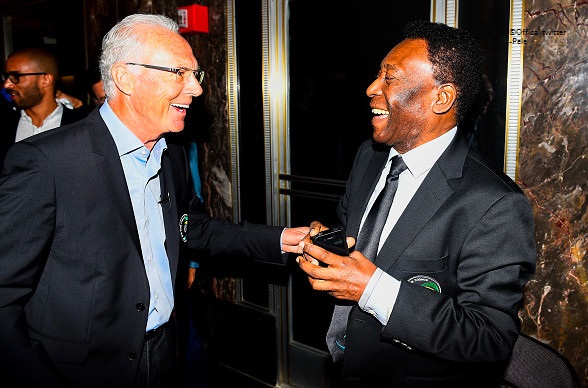What ISL should learn from the tale of New York Cosmos

Now that the dust has settled on two seasons of the ISL, the time is right to make an initial assessment of its impact on football viewership and sustainable football development in India. As far as football viewership goes, the verdict is resoundingly positive. IMG and AIFF pulled out all the stops for the competition, taking care of everything from extensive TV coverage and gilded star names to a viewer-friendly format and generous sprinklings of Bollywood and cricket. This confluence of hype, talent, and visibility went down well with Indian crowds, with many franchises already garnering a loyal fan following and domestic football being talked about with a ferocity and loudness hitherto never seen in the country.
The reading gets a bit sobering and murky when one moves on to the ISL’s impact on sustainable football development in India. Although the domestic player rule means that enough Indian players get a chance, there has been much opprobrium rained down upon the organizers and individual teams for not releasing Indian players to let them attend training camps before important international fixtures. There is a broader scepticism about the shortness of the format itself, questions being asked
Although not discernible prima facie, there are eerie similarities between the ISL’s current tightrope-walk and a club from the USA that took the world by storm in the 1970s. The New York Cosmos brought football to the US like the ISL is currently attempting to in India – in a maelstrom of glitzy confetti and global stalwarts – and succeeded greatly for a decade before imploding in an unmanageable blob of financial failure and waning public interest. It is worth looking at the rise and fall of the New York Cosmos to draw parallels with the current ISL landscape, take heart from the mistakes made then which haven’t been made now, at least not yet, and touch gingerly upon the mistakes which are being repeated.
Twin Sleeping Giants
If we think India is a nation with
In comparison, India seems positively football-crazed. Although the I-League has paltry crowds and minimal television presence, there are notable exceptions (The teams from Bengal and Bengaluru FC to name a few) where hordes of supporters get behind the teams. In addition, the English Premier League broadcasting explosion in the subcontinent over the past decade has left in its wake millions of fervent fans who swear by Manchester devils and Liverbirds. Although the ISL has done a fine job in bringing a successful franchise-based football tournament to India, its feat is dwarfed by what Steve Ross did for North American soccer.
Benevolent Moguls
If it wasn’t for Steve Ross, the founder of Warner Communications and arguably the world’s first media mogul, the heady heights of the New York Cosmos would have never seen reality. Ross, along with Turkish-American brothers Ahmet and Nesuhi Ertegün, laid the seeds of the New York Cosmos with a $1 million investment. Although the initial team was replete with part-timers and misfits, and barely got 50 people to attend their games, they won the NASL title and hooked the most important fan of them all: Ross himself. He bought out all other investors’ shares, put the Warner name completely behind the Cosmos, and moved them to Randall’s Stadium – closer to the city – to attract more fans. It would be a while before the sport’s popularity would explode in the US, but Ross’s initial bold moves paved the way for future successes.
Closer to the here and now, IMG has played an even more pivotal role by practically setting up the entire ISL in collaboration with the AIFF and Star Sports. Bankrolled by business magnate Mukesh Ambani’s Reliance Industries, IMG is responsible for the sponsorship, advertising, broadcasting, merchandising, and franchising of the ISL. Cynics murmur about sports and entertainment companies being good havens to convert black money into white, but regardless of these extraneous objectives, it can’t be denied that IMG’s ownership and proactivity have played a large part in ISL’s strong showings so far.
(Also Read: An open letter to Nita Ambani from an Indian football fan)
Stars of Blinding Light
Although the NASL and the New York Cosmos were trudging along, hardly anybody in the USA knew or cared. Reporters hardly visited any soccer games, and the only mention the Cosmos got in the papers till 1974 was a full page nude spread of their goalkeeper Shep Messing in an adult magazine. 1974 is when things changed for good.
Pelé – worldwide soccer sensation, multiple time World Cup winner, Brazilian national treasure – had just retired from his lifelong club Santos. The Cosmos had already tried to sign him in 1970 after seeing him at the World Cup, but to no avail. They weren’t going to miss this second chance. Might and muscle – both financial through the monetary prowess of Warner Communications, and political through the cajoling of unlikely soccer fan Henry Kissinger (former US Secretary of State) – were employed to ensure that Pelé chose the Cosmos over other suitors such as Real Madrid and Juventus.
“Real Madrid and Juventus were sniffing around, so I said, ‘If you go to Real or Juventus all you could win is another championship, whereas if you come with us you could win a country,’” Clive Toye had said.
The signing of Pelé immediately tripled attendance figures for the Cosmos and even raised the roof at opposition stadiums. Swarms of journalists started covering soccer where earlier there had been virtually none. Other NASL franchises scouted and secured their own ‘marquee’ signings such as Gordon Banks, George Best, and Rodney Marsh. But none of them could match the resplendent stardust of the Cosmos: after Pelé, they bought Giorgio Chinaglia, prolific Italian striker from Lazio, Carlos Alberto, Brazilian captain of the 1970 World Cup winning team, and Franz Beckenbauer, German heavyweight in his prime. The Cosmos were hipster Galacticos, building star-studded teams before it was cool.
All of this sporting effort and financial outlay paid off in
The ISL has started in a similar vein, roping
Made-To-Measure Football
The NASL knew that only big-name hires wouldn’t be enough to sustain public interest; the sport itself would need to be morphed to suit the American palate. The entire league was centred around entertainment and results. The NASL Shootout was introduced to ensure that all games ended with a
The Cosmos locker room also became Hollywood’s new red carpet, boasting celebrity fans like Robert Redford and Steven Spielberg. Steve Marshall, Cosmos’ travel secretary, recalls: “I remember once, Gordon Bradley, looked over in the corner [of the locker room] and saw this guy with longish hair, skinny as a rail, looked like he was on drugs. Bradley told our security guy, ‘Get that guy out of here!’” The person he was referring to was Mick Jagger.
In comparison, the ISL has not really Indianised the sport as much as IPL-
Blinding Stars or Red Giants?
Star players always come with the added baggage of massive egos that need constant massaging. For the Cosmos, that player was Giorgio Chinaglia. A fiery Italian, who referred to himself in
Intriguingly, Chinaglia had converted one fan: Steve Ross. Chinaglia always had Ross’ ear, and the Warner boss could often be seen walking around in the Italian’s soccer shorts. After Pelé retired, Chinaglia’s corrosive power within the team grew even more, and he convinced Ross to fire the manager and himself took over the role of player-manager. Needless to say, that didn’t go too well and played a sizable role in the Cosmos’ eventual demise.
Player and league power have reared their ugly heads in the ISL too. Multiple franchises didn’t release Indian players for important World Cup qualifier matches, citing the importance of ISL matches as a laughable reason. The case of Nicolas Anelka is also well-known: personal differences and
Moguls in the Mud
The dangers of sporting teams being completely backed by corporate houses is that the sporting team is usually the first project to be shelved when other arms of the corporate house go awry. So it was with Warner Communications. Wrong allocation of funds in movie and video game deals, production failures, tax burdens, and the steep fall from grace of Atari (the video game division of Warner) meant that the firm was making losses left, right, and centre. The New York Cosmos was a vanity project at the best of times, and with other facets of business faring badly, Ross and co. had no other option but to jump ship.
What ailed the Cosmos
Although the ISL has fortunately not run into any financial worries so far, it is still early days. Moreover,
To sum up, there are many similarities between the meteoric rise and precipitous fall of the New York Cosmos with the story of the ISL unfolding before us now. There are a few things that the Cosmos and NASL did well that are being repeated by the ISL, but there are also worrying road-bumps that are being driven over again with no regard to the accidents of the 1970s.
Einstein rightly said that insanity was doing the same thing again and again while expecting different results. As a country, let us hope that ISL has their sanity with them and is cognizant of the past while deciding for the future.

Comments
Sign up or log in to your account to leave comments and reactions
0 Comments